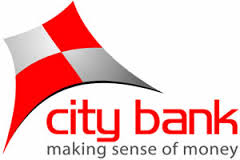Internship Experience at City Bank Limited
Banks play an important role in the economy of the country. After liberation except the foreign banks all banks were nationalized. These banks were merged and grouped into six commercial banks. Of the total six commercial banks Uttara and Pubali were transferred to private sector from 1985. Now there are four nationalized commercial banks namely Agrani, Janata, Rupali, and Sonali Bank. There are four specialized banks in our country. In addition to this 49 private commercial banks are in our country at present. Of these 49 private commercial banks there are 12 foreign banks, 28 private banks incorporated in our country except Islamic banks and 4 Islamic banks. In 2005, these banks were operating their banking activities through 6038 (June of 2000) branches. The bank and the other financial institutions have become dynamic after taking initiatives to reform the banking sector by the finance minister of Bangladesh. The basic issues are decreasing the amount of loan and increasing paid up capital through decreasing the interest rate of deposit and investment, changing the principles of rescheduling the bank.
History of the City Bank Limited (CBL):
The City Bank Limited (CBL) is the first private sector Bank in Bangladesh. The Bank has been operating since 1983 with an authorized capital of Tk. 1.75 Billion under the entrepreneurship of twelve prominent & leading businessman of the country. The noble intention behind starting this Bank was to bring about qualitative changes in the area of Banking and Financial management. Today, The City Bank serves it’s customers at home & abroad with 77 branches spread over the country & about three hundred oversea correspondences covering all the major cities and business center ofthe world.
Shareholders information:
The City Bank Limited was incorporated on 14.3.1983 as a Public Ltd. Company Under The Companies Act- 19\3. It got Certificate Of Commencement Of Business On 20.3.1983 and formally started banking operation from 27.3.1983.
Authorized Capital: Tk. 1.75 Billion
Total Number Of Share: 17,500,000
Market Lot Of Share: Five
Face Value Per Share: Tk. 1001-
At present, there are about 5,678 Shareholders approximately.
Vision & Mission of CBL
Corporate Vision
To be the leading bank in the country with best practices and highest social commitment.
Corporate Mission
- To contribute to the socio economic development of the country
- To attain highest level of customer satisfaction through extension of services by dedicated and motivated team of professional team of professionals
- To maintain continuous growth of market share ensuring quality
- To maximize bank’s profits by ensuring its steady growth
- To maintain the high moral and ethical standards
- To ensure participative management system and empowerment of Human Resources
- To nurture and enabling environment where innovativeness and performance is rewarded.
Vision for the Future:
Maintaining the existing growth, Management expects, the Bank will show good business profile in 2006 .The Bank reorganized its structural set up, Asset Liability Management (ALM) put in place, focused on various risk management, corporate governance and inculcation of corporate culture within the Bank. Review of emoluments for the employees based on market demand, providing performance bonus to the employees, introduction of Best Managers and Best Employees award would certainly put the Bank on a elevated position in the market. The Bank implemented Ethical Guide Lines for the employees. For improved working regulations Internal Control and Compliance division was setup. IT infrastructure development, extending online banking facility to more branches, establishing A TM at important places of the country, greater SME financing and improved personal banking facilities etc. are on the card. The Bank is aiming to be the leading financial institution in the country.
To become the leading private sector bank in the country the Bank has to grow at a faster pace in this competitive market. To achieve the prime position, other than online banking facility covering with most of our important branches all over the country, dual currency CITYCARD operation, POS, SME loans we are in the process of implementing Electronic Delivery channels: ATM, Debit Card etc.
Description of the Internship:
During my internship I worked according to the following routine:
I spent 45 hours per week at work on internship project. I tried to participate directly or indirectly in the daily operational activities of the branch.
Specific responsibilities of the Jobs:
As an intern, I have no specific job responsibility in the branch. I observed activities of almost all departments. But I carry out some responsibilities also:
- In the general banking department, I helped the clients to fill up the account open form.
- I gave information about different scheme of CBL that are offered.
- I involved directly preparing the Bangladesh Bank’s Returns of Foreign Trade & foreign exchange transactions for the month of July of the Branch.
- I prepared the IBEA (Inter Branch Exchange Advice) for the Head office.
- I prepared some vouchers for the Import LlC.
- I wrote down PAD (Payment Against Document) register in the Import LlC Section.
- I wrote down Liability and Cash Margin Register for PAD (Payment Against Document) in the Import LlC Section
These are some responsibilities that I carried in the Gulshan Branch.
Different aspect of job performance:
At first I started my internship from General Banking Department. I observed activities of different sections, namely Account Opening section, Cheque Book Issue and Dispatch section, Remittance Section, Clearing and Bills Section, Accounts Section, Cash Section.
Then I worked with Loan & Advance department. I got knowledge about various aspects of loans. I also knew how the credit officer analyses credit proposal and disburse credit if proposal is sound. I knew about different kinds of loan like secured, unsecured, hypo, pledge, cash credit etc.
At the end I worked in Foreign Exchange department. In this department, I facilitated the official for receiving and preparing the LlC (letter of Credit) document. I got knowledge about LlC, PAD, LTR, LIM, ECC, and PCC, bill Purchase, F.C account etc.
Critical Observation:
This is a well-established statement that practical situations always differ from theoretical explanation. During the two and half months internship program at Gulshan Branch almost all the desks I have been observed. And I have found theory deviates from the practice more or less though two and half months are not enough time to find out all the discrepancy between theory and practice.
Among all experiences some noticeable observations are described below:
- Customer service is not fast because of few computers in this branch.
- Processing of cheque and account open take long time. Sometimes it takes more than an hour for processing.
- The bank personnel and officials are very busy with their occupational activities. So, it is little difficult for them to complete their work in schedule time.
- There are few computers in this So the officials have to share the computers. It slowdowns the work performance.
- Some of the officers and staff are not
- CBL takes long time to disburse the big loan.
- Information about old and new clients is not upto date.
Other then these, the officers were mostly courteous, friendly in nature and eager to help despite the tremendous workload. As a private bank, CBL Bank is trying it’s best to extend their service to the public.
Recommendation:
- Branch should intensify its quality of client services: Branch must be careful about the quality of its service. To keep the customers in the branch, proper value should be given to them while they are in the
- Add new features: CBL should diversify its banking servIce and add new features in its service so that it can attract customers from all groups of
- Information about client: It is important to keep close personal and extra friendly relationship with client for obtaining first hand information, as early as
- More power to branch manager: For reducing loan-processing time branch manager should be given more power to sanction
- Proper training: Proper training must need to improve the efficiency of employees.
- Unique Product: CBL should provide any unique service that can attract new
- Information system should be developed: Information system with in branch must be All the branches must be online. So that it can communicate with other branches very quickly.
- Insurance Facilities: CBL should give more Insurance facilities to their clients.
Foreign Exchange
Introduction:
Foreign Exchange, like Foreign Trade is a part of economic activities of a country. The term foreign Exchange is defined as ‘the system or the process of converting one national currency into another and of transferring money from one country to another”.
Foreign Exchange as Foreign Currency, which includes deposits, credits, and balances payable in Foreign Currency as well as Drafts, Traveler’s Cheques, Letter of Credit, Bill of Exchange drawn in local currency but payable in Foreign Currency.
Thus, the international trade and movement of money and capital are the mainsprings of Foreign Exchange dealings. In the modem day, the Banking service specially foreign department, is performing a great role, dealing with Foreign Trade, which are as follows:
- I) Import
2) Export
3) Foreign Remittance
At Gulshan Br. ofCBL, foreign Exchange department has divided into 3 distinct sections. These are i) Import Section, ji) Export Section and iii) Foreign Remittance Section.
Some national and international laws regulate functions of this department. Among these,
Foreign Exchange Act, 1947 is for dealing in foreign exchange business and Import and Export control Act, 1950 is for Documentary Credits (UC’PDC-1993 revision & International chamber of terms and conditions between exporter and importer law for settlement of terms and condition between exporter and importer in international factors for import and export operation for banks).
The main product of Import section is LlC (Letter of Credit) operation to import goods in the country. Now, I start the discussion with the operation of import section.
Import Department:
Import section helps business and other people to import goods. In international environment, buyers and sellers are often unknown to each other. So sellers always seek guarantee for the payment for his goods exported. During this time, Bank gives export guarantee that it will pay for the goods on behalf of the buyer. This guarantee is called letter of Credit. Thus the banker gives the contact between importer and exporter by its “Letter of Credit”
Import (LIC)
A letter of credit is a letter by a bank (known as the opening or the issuing bank) at the instance of its customer (known as the opener) addressed to a person or a company (beneficiary) undertaking that the bills drawn by the beneficiary will be duly honored by it (opening bank) provided certain conditions mentioned in the letter have complied with.
When a buyer goes to import some goods from a foreign buyer, he requests his bank make payments to the exporter of goods. And the bank recovers the amount from the importer.
Steps for Import LIC Operation
Registration with CCI & E:
For engaging in international trade, every trader must be first registered with the Chief Controller of Import and Export. Trade can take license only for import or only for export or both. For getting license, trader has to pay some specified fees to the CCI & E.
The license is called IRCIERC – (lmportlExport registration Certificate). For opening LlC with bank, this IRC must be showed to the bank.
Determination terms of Credit:
The term of the letter of credit is depending upon the contract between the importer and exporter. The terms of the credit specify the amount of credit, name and address of the beneficiary and opener, tenor of the bill of exchange, period and mode of shipment and of destination, nature of credit, expiry date, name and number of sets of shipping documents etc.
Application by importer to the banker to open letter of credit:
For opening LlC, the importer is required to fill up a prescribed application form pro·. ided by the banker. This prescribed application form includes details of import information including terms of credit. It is evidence of agreement between the importer and the banker.
Document required with LlC application Form:
- Pro-forma invoice / Indent Invoice
- Liability Sheet
- Demand Promissory Note
- Authority to debit account
- A filled up amendment request form
- A declaration of importer that his application has no illegal matter.
- IMP form
- Insurance cover note, etc.
Opening ofL/C by the bank for the opener:
After getting filled up application form from the importer, the banker may open letter of credit in favor of exporter if the bank satisfies with the credit worthiness of his customer. But, before opening LlC, bank collects credit of exporter from exporter’s country through his foreign correspondence there. Opening bank then issues credit by air mail or cable followed by credit advice as asked for by the opener through his foreign correspondent or Advising bank as the beneficiary on his own form where it is addressed.
The opening banker’s credit advice contains all information of the credit and a reimbursement clause stating how the negotiating banker would get reimbursement of his payment made against the documents. The reimbursement of his payment made against the documents. The reimbursement agreement may be to debit of the opening banker’s account held with the negotiating bank of opening banker in the place of beneficiary.
Such account is called NOSTRO ACCOUNT. If no NOSTRO ACCOUNT is maintained in the beneficiary’s country, then the negotiating bank is asked to claim reir.Jbursement from another bank either at the place of beneficiary or else where by drawing a reimbursement draft.
Credit Facilitates:
During LlC operation some Credit facilities evolved to the importer. This credit facilitates are mentioned below:
Payment Against Documents (PAD):
This loan is related to cash LlC after opening LlC foreign exporter sends goods to the importer and a bill of exchange along with shipping documents to the LlC opening banle Upon receiving bill of exchange and other documents, bank immediately make payment to the exporter if no discrepant is found on the shipping documents. Bank hands over the shipping documents to the importer only to exporter on the basis of shipping documents, this is called payment documents.
Loan against Imported Merchandise (LIM):
LIM is occurred from PAD. After payment to the exporter on the basis of shipping documents, bank recovers the amount from the importer. The negotiation bank Sends bill of exchange to the Opening Bank. In this case, importer requests to the opening bank to treat PAD as credit and hand over the shipping documents to him so that he can clear the imported goods from the port. Then bank converts the PAD to regular credit and hand over the documents to loan. Since this loan is given on the imported goods, this is called Loan against Imported Merchandise. Duration of this loan is one month only, If the loan is no repaid after one month, it is treated as forced LIM.
Loan Against Trust Receipt (L TR):
L TR is also a post shipment import finance like LIM. The essential difference is that in L TR, shipping documents are delivered to the client on trust. The act of trust is based on past experience with and credit worthiness of client. L TR facilities usually have validity of 60 to 90 days. In industrial units, period of limit may be longer. In case of this facility, the clients always pay duty and charges. The Bank Manager must be absolutely sure that the client will deposits the sale proceeds towards payment of the bank dues within the stipulated period.
Miscellaneous services provide by this Department:
Student File Open:
Students who are desirous to study abroad can open file in this bank. By opening this file, bank assures the remittance of funds in abroad for study. Moreover, Bank sends financial information to the diplomatic office, which is very helpful for opener to get visa.
Foreign Transfer:
Foreign Demand Draft: Bank issues Demand Draft in favor of purchaser or any other according to instruction of purchaser. The payee can collect it for the drawee bank in which the Issuing bank of Demand Draft holds its NOSTRO Account. Bank also makes payment on DO drawn on this bank by its foreign correspondence bank through the VOSTRO Account. In the process of remittance, bank must have to make profit as a business institution. Bank makes profit in two ways· I. Commission charge and 2. Differences between the buying and selling rate.
Telex Transfer
Outwared IT: Bank also remit fund by tested telegraphich message via its foreigncorrespondence bank in which it is maintaining its NOSTRO Account.
Incoming IT: In the same manner, CBL makes payment according to telegraphic message of its foreign correspondence bank from the corresponding VOSTRO Account.
Cash Remittance
Cash Dollar/Pound Sell: Bank sells DollarlPound for using in abroad by the purchaser. The maximum amount of such sell is mentioned in the Bangladesh Bank publication of Convertibility of Taka for Currency Transactions in Bangladesh.
Cash Dollar/Pound purchase: Bank can purchase dollar from resident and nonresident Bangladeshi and Foreigner. Most dollars purchased comes from realization of Export bill of exchange.
These are the varIOUS types services given and operated by Foreign Exchange Department.
















